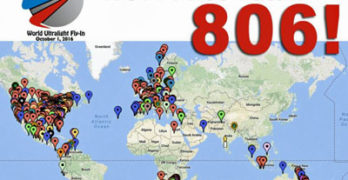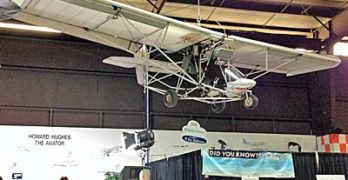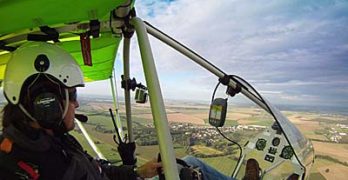WUFI ’16 — It’s tomorrow in New Zealand. Weird as it seems to write that, the down-under nation is 17 hours ahead of those of us on America’s east coast. So, pilots in that nation will lead the parade as ultralights and other open-cockpit aircraft kick off the World Ultralight Fly-In on October 1st, a global day in the sky. If you have one of these aircraft, I hope you log on to their map and add your pin and info to the group.
As of September 30th, the day before WUFI Day, more than 800 pilots had already shown their support for the “movement” to have some joy in the air aboard your light flying machine. Organizer Dayton Ultralights and Facebook regular Paul Lindamood were looking for 1,000 pilots to join the party. Given normal human propensity to wait to act, it might happen.
Search Results for : SSDR
Not finding exactly what you expected? Try our advanced search option.
Select a manufacturer to go straight to all our content about that manufacturer.
Select an aircraft model to go straight to all our content about that model.
Aerolite 120 Launches in Britain and Ireland
Aerolite 103 from U-Fly-It has been on a tear for the last couple years, producing at capacity and stretching to produce even more for 2016. Some of those very attractively priced aircraft — way under $20,000 ready-to-fly! … take that, sluggish economy! — are headed off on the longest trip of their lives. The DeLand, Florida company has been shipping units to Europe where their German-based European distributor operates.
So much for too-costly airplanes. Aerolite 103 (and a few other well-priced examples from light aircraft producers) proves an airplane doesn’t have to be costly to deliver a good time. The German Aerolite 120 is somewhat costlier to account for shipping, German certification expense, etc.
“British pilots have embraced Aerolite 120,” said German distributor Vierwerk Aviation. “Aerolite’s proper design, very good quality, and meticulous workmanship in every detail have been praised and recognized by everyone.” Aerolite 120 is the European-approved version of America’s Aerolite 103.
Innovative Hybrid: Jet Power with Electric Motor
Some people, myself included, love soaring flight. As the following article from Dave Unwin explains, to use his words, “Soaring flight exercises a fascination that is both difficult to explain and hard to resist, sometimes called ‘three-dimensional sailing.’ Flying a heavier-than-air machine for several hours and hundreds of miles by using the atmosphere as the fuel possesses an undeniable attraction.” As he further explained in a longer article, the downside is getting airborne for soaring flight. Various alternatives have been explored. Some were reasonable; others were too marginal to be enjoyed. In the following piece Dave tells about a new aircraft that might solve this problem, one that can fit England’s innovative SSDR 300 (kilogram) category. —DJ
Article Updated 6/17/15 — ProAirsport announced, “We have now released a priority price of 39,950 British pounds (about $63,000). More details can be found on our website.” This is an excellent value for a motorglider.
PSA: An Affordable Aircraft?
The following article is a guest editorial by Chip Erwin, a name many rightfully associate with the highly successful SportCruiser LSA. A restless entrepreneur, Chip has been working behind the curtain for several years. He emerged with the Zigolo and is now proposing a fresh name for a segment that seems to have energy behind it. I have reported on England’s new SSDR 300 category and I have observed the rejuvenation of Part 103 vehicles. So, on our recent travels to China, I encouraged Chip to express what he has in mind.
Article Update 6/15/15 — At the end of this article see our video shot at Sun ‘n Fun 2015 regarding Chip’s electric motor and plans.
Is “affordable aircraft” an oxymoron? For most people, probably yes. One answer could be a class of aircraft I like to refer to as a PSA, or Personal Sport Aircraft.
Is FAA Falling Behind Other National CAAs?
Let’s set the way-back machine to two dates and examine the actions of our good friends at FAA. One date was September 1982. Another date was September 2004.
Date #1 was the time when FAA announced Mike Sacrey and team’s remarkable Part 103. This rule has lasted for 33 years and continues to hold interest (see earlier article on the subject). Date #2 was when FAA announced the SP/LSA rule engineered by Sue Gardner and her team. I continue to applaud their initiative for both simplified rules where they stepped far back and let the market do its magic. Both have increased the freedom of pilots to fly what and how they prefer. Kudos, FAAers!
Part 103 is strictly single seat since the two-seat “103 trainers” were forced into ELSA status. Does a market exist for one-place aircraft? I always cite this survey result from AOPA. After many years of asking, the big member group determined the average occupancy of a GA aircraft was 1.6 persons.
Sun ‘n Fun 2015: Part 103 Ultralights Are Hot!
Part 103 ultralight activity was not the news I expected to report from Sun ‘n Fun 2015, certainly not as my first report. After an intense week shooting video interviews at Sun ‘n Fun 2015, I am impressed to report that Part 103 is much more than alive and well. For those that may have missed this unique category, Part 103 ultralight vehicles (FAA’s deliberate wording) are single seat flying machines of varying description that need no medical, not even a pilot license, no N-number registration, and can be sold ready-to-fly. The entire FAA regulation for them can be printed on the front and back of a single piece of paper.
Adding to the charm of rarely having to interact with a government agency in order to have some fun in your airplane are a couple similar efforts in Europe. Germany has its 120-kilogram class (264 pounds) and England has its SSDR category (Single Seat De Regulated).
Fresh American LSA & Ultralight Exports
Wait! “…Exports?” I realize that might look like a typo. Did I intend to write LSA imports? Nope, exports is the correct word. Back in the early days of Light-Sport Aircraft, circa 2005-6-7, the source countries manufacturing the LSA people were buying were of a high percentage European with the Czech Republic leading the charge. Their penetration of the market was approximately two-thirds of all LSA. Then came the global economic recession, which happened as the industry began to mature. All were affected: domestic and international companies and pilot consumers. Some handsome imported aircraft never found a market.
In any downturn, some managers adapt quicker to the changing economy. They find a way to offer new aircraft to keep the momentum. Neither were American companies sitting on their thumbs. European builders had a head start because the European-style ultralights they had been manufacturing were close to what FAA allowed as LSA, so many models could be rapidly adapted to meet the Yankee marketplace.
Light Is Right In the Eyes of FAA and World CAAs
Evidently, a magic number exists to authorities in various civil aviation agencies around the developed world. That magic number — more correctly a range — is 115 to 120 kilograms, or 253 to 264 pounds. FAA led this charge way back in 1982 with the introduction of FAR Part 103 codifying that an airplane, ‘er … “ultralight vehicle” with an empty weight of 254 pounds — subject to certain exceptions for emergency airframe parachutes or float equipment — could be flown without three requirements common to all other aircraft. Part 103 vehicles• do not require registration (N-numbers); the pilots of these ultralights need no pilot certificate of any kind; nor do they need a medical. Such aircraft can be sold fully built, ready to fly. The entire regulation governing their use can be printed on the front and back of a single page of paper. This simply must be one of the most remarkable deregulatory efforts in all of aviation.
Zigolo Cracks the China Market as Part 103!
I didn’t see this one coming. Maybe you didn’t either? In the new millennia gold rush represented by companies either being bought by Chinese businesses or gaining investment from wealthy Chinese business people or by setting up shop to sell in China (or even Cessna’s ill-fated effort to have their Skycatcher manufactured in China), one element I’ve never heard of is Part 103 in China. This least-regulated-of-all aviation category is solely an American thing, isn’t it? Well … yes and no. Germany has opened the door to a Part 103-like development in that country under the 120-kilogram class (using a number that is 264 pounds or very similar to Part 103’s 254-pound empty weight limit). England has their SSDR class (SSDR being the abbreviation for Single Seat De-Regulated). Despite following those developments, I’ve never heard a word about China and any less-regulated sector.
“The first Zigolo in China was introduced to the public in that nation on July 17th at the Jingmen Airshow,” reported representative Chip W.
Aero 2014 Review … Starting to Think AirVenture
Life has settled down a little after the rush that began at the end of March. Five weeks back, Sun ‘n Fun was approaching to kick off the season of recreational flying.
Aero in Germany followed with only a one day break before boarding the airliner to Europe followed by plenty of follow-up and contemplating the hot and fast action. With a couple weeks of perspective and to answer a common question — How does the industry look in Europe? — I have some final observations.
I found five areas to consider and list them below. Among all the many wonderful aircraft I saw, two particular subgroups stood out for me personally, one for its sheer success and the other for its subtle return to a higher interest plateau.
I refer first to gyroplanes and secondly to, well … what to call them? How about simply “ultralights?” Even that word isn’t right because Ultralight in Europe means something quite different from ultralight (vehicle) in the USA.











